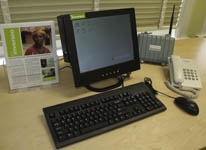Yesterday Jeremy Faludi interviewed Laura Mellow, COO of Inveneo for the World Changing website. While most of the article focused on Inveneo's work, I noticed that Jeremy asked Laura this question:
"Your "Inveneo Communication Stations" sound similar to the One Laptop Per Child (OLPC) project, except that yours already work and already exist in the field. How long have they been out and how do they compare to OLPC?"What was most telling in her response is that she didn't compare the Inveneo solution to OLPC, in fact, she didn't even mention it. Jeremy had to draw his own conclusion of:
"[Thus, the main design difference appears to be that Inveneo's computers don't contain a power source inside them, but rely on external sources; the lack of moving parts is also a significant difference, which should make them very robust--she doesn't just mean no external parts, she means no internal fan, which will be helpful in dusty/dirty environments. The use of off-the-shelf parts may be the main reason they're already on the ground, and it should help with repairs & maintenance.]"What Jeremy fails to recognize is that Inveneo's Communication Station is just that - a way for isolated communities to communicate, a whole different goal than the One Laptop per Child's, which is to develop a low-cost laptop to revolutionize children's education.
To compare the two would be like asking a mobile/cellular phone provider how its telephones compared to a elementary classroom chalkboard or library, or the simple "apples to oranges" expression. Inveneo is in the communication business, OLPC is in the laptop design education business.
The OLPC 2B1 comparison is also the question that everyone in the information and communication technologies for development (ICT4Dev) field is starting to dread. As if all their work should somehow be held to the OLPC yardstick.
This is especially insulting to organizations like Inveneo that have production-level solutions on the ground, already up and running, which are providing objective, measurable, and profitable results, unlike the still very-prototype 2B1 Children's Machine.
Still, with the OLPC marketing machine in high gear, expect to see more interviews where already implemented and even self-sustainable technology for development projects are asked to benchmark themselves against what is still very much an idea without any real-world testing or implementation.


